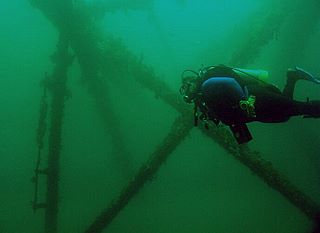by Bruce Wells | Jul 27, 2025 | Offshore History, Petroleum in War
Routine seabed scan for new pipeline revealed Nazi sub less than one mile from its last victim.
During World War II, U-boats prowled the Gulf of Mexico to disrupt the flow of oil carried by tankers departing ports in Louisiana and Texas. Sixty years later, seabed surveys found U-166 — and its last victim.
Petroleum exploration and production companies operating in the U.S. outer continental shelf (OCS) typically provide government scientists with sonar data for areas with potential archaeological value. (more…)
by Bruce Wells | Jul 1, 2025 | Offshore History
The U.S. offshore petroleum industry began with drilling and production from platforms constructed on lakes in Ohio and Louisiana and on California oil piers. In Ohio, state geologists reported oil wells drilled on Grand Lake as early as 1891. Dozens of wells on Louisiana’s Caddo Lake also produced oil in 1911.
By 1897, Henry Williams had successfully pursued the giant Summerland, California, oilfield to the scenic cliffside beaches of Santa Barbara.
California Oil Piers
With reports of “tar balls” on the beaches from natural offshore oil seeps, Williams recognized that the highly productive field extended into the Pacific Ocean. He and his associates constructed a 300-foot pier, mounted a cable-tool derrick, and began drilling. (more…)
by Bruce Wells | Jun 7, 2025 | Offshore History
The world’s first mobile offshore drilling unit (MODU) began in the mind of World War II Navy veteran Alden “Doc” Laborde, who believed a self-sufficient oil rig could be placed on a barge for deeper offshore drilling. Laborde applied his naval experience to design and build the first submersible offshore drilling rig.
The American Society of Mechanical Engineers (ASME) in 2012 designated Mr. Charlie an ASME Historic Mechanical Engineering Landmark. Today, Laborde’s offshore platform is a Louisiana museum and education center, a national historic landmark, and “glimpse into the past” for the offshore petroleum industry.
(more…)
by Bruce Wells | Apr 23, 2025 | Offshore History
Thomas Rowland’s Continental Iron Works produced gas fittings, welded oil storage tanks, and a famous ironclad.
The origins of the modern offshore oil exploration and production industry must include the 1869 offshore rig patent “Rock Drill” design of a skilled New York engineer.
On May 4, 1869, Thomas Fitch Rowland, owner of Continental Iron Works in Greenpoint, New York, received a U.S. patent for an unusual “submarine drilling apparatus.” His patent (No. 89,794) for a fixed, offshore drilling platform came just 10 years after America’s first commercial oil discovery in Titusville, Pennsylvania.
(more…)
by Bruce Wells | Apr 1, 2025 | Offshore History
Atomic Energy Commission robot inspired offshore petroleum industry’s remotely operated vehicles.
Shell Oil and Hughes Aircraft in 1960 began modifying an advanced but landlocked “manipulator operated robot” — soon known as Mobot — into one that could operate underwater. The result would lead to revolutionary offshore swimming machines for petroleum exploration and production.
Much of the 21st-century’s offshore oil and natural gas industry has relied on remotely operated vehicles (ROVs) that can trace their roots back to Howard Hughes, Jr. In the late 1950s, Hughes Aircraft created the Manipulator Operated Robot – Mobot – for the Atomic Energy Commission. (more…)
by Bruce Wells | Feb 28, 2025 | Offshore History
Thousands of offshore petroleum structures provide energy — and marine habitats.
Offshore petroleum platforms act as artificial reefs, creating important marine habitats, according to scientists. Beginning with an Exxon experimental subsea structure in 1979, the U.S. government’s “Rigs to Reefs” program established the largest artificial habitat in the world.
The Gulf of Mexico, both onshore and offshore, has continued to be a key contributor to U.S. oil and natural gas resources and energy infrastructure. Federal offshore oil production in 2023 accounted for 15 percent of total U.S. crude oil and five percent of natural gas production, according to the U.S. Energy Information Administration (EIA).

Offshore platforms make good artificial reefs. The open design attracts fish — and divers — where they can swim easily through the circulating water. Photo courtesy U.S. Bureau of Safety and Environmental Enforcement.
(more…)


